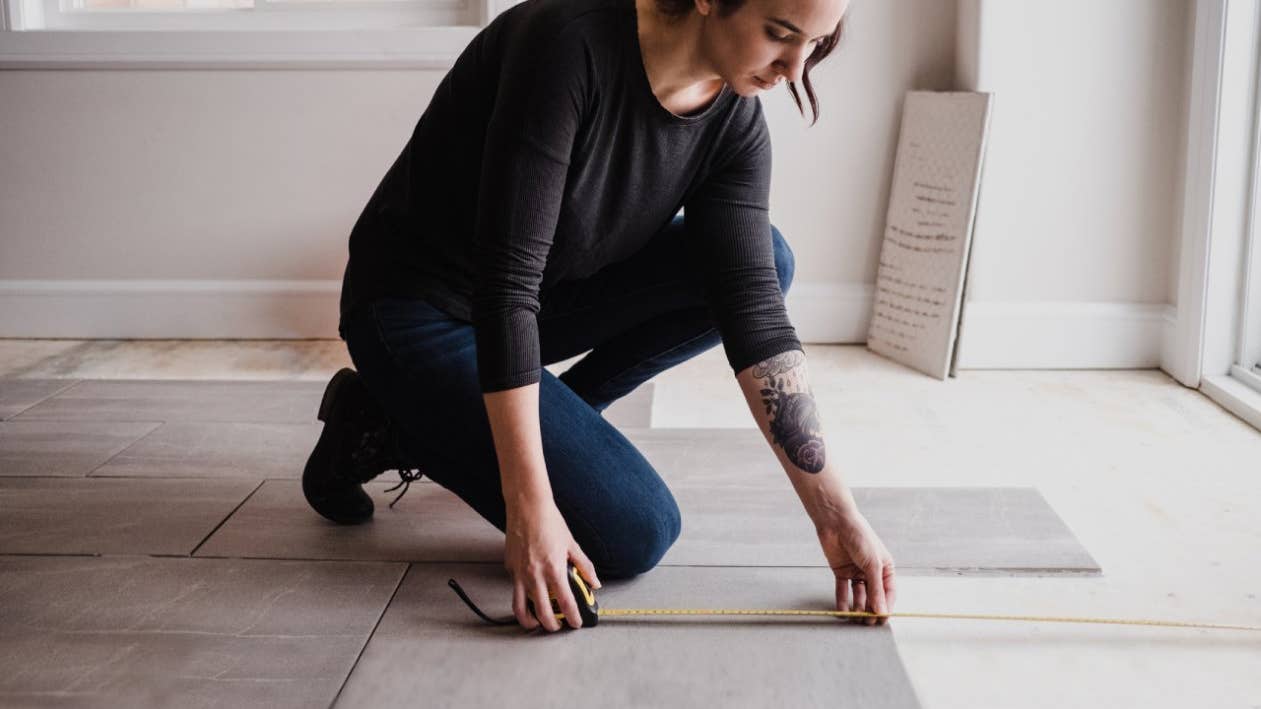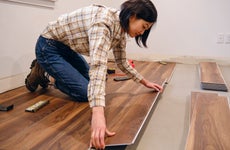How to install floor tile

The Bankrate promise
At Bankrate we strive to help you make smarter financial decisions. While we adhere to strict , this post may contain references to products from our partners. Here's an explanation for .
If you’re thinking about ways to renovate your home, installing a new tile floor is a great option. Not only is tile a versatile material that can be used in kitchens, bathrooms and bedrooms, but it also comes in countless styles to customize the look and feel of your floor.
Plus, if you install it yourself rather than hiring a professional, you could potentially save hundreds or thousands of dollars in labor costs (depending on the size of your room, the type of tile you choose and a few other factors).
“Tiling a floor is a very doable and safe-to-tackle project for most DIYers,” said James Upton, a certified tile installer and the creator of DIYTileGuy, a tile installation blog. “Unlike tiling a shower, re-tiling a floor isn’t something that involves plumbing or potential water damage to the home.”
Though DIY tile installation isn’t overly complicated, a fair amount of patience and preparation is required.
What you’ll need to tile a floor
Of course, there are the tiles themselves: porcelain, ceramic and natural stone are popular options, but they’re only part of the equation. You’ll also need several other tools and materials for the project:
- Wet tile saw or snap cutter
- Rubber mallet
- Spacers
- Notched trowel
- Tile nipper
- Thin-set mortar
- Grout
- Chalk line
- Tape measure
- Electric drill
- Rubber float
- Level
- Sponges
- Buckets
- Cement backer board
- Cement board screws
- Fiberglass tape
How to prepare the floor
Preparation is key when it comes to installing tile. Most importantly, the floor needs to be clean, level and strong enough to support tile, grout and all of your furniture when finished.
In many cases, proper preparation means installing a cement backer board on top of your subfloor or over your existing tiles to provide a sturdy and flat surface to lay your tiles. But it’s unnecessary if you already have concrete floors, to which you can attach the tiles directly (just make sure they’re clean and level).
You can find sheets of backer board at your local hardware or tile store and cut them to fit your room. Then, using a notched trowel, apply an even layer of thin-set mortar to your subfloor, lay down the backer board and secure it with cement board screws around the edges of the board. Finally, apply fiberglass tape where the edges meet and cover the tape with another layer of mortar.
How to install floor tile
Once your backer board has set (at least 24 hours after laying it), you can begin installing your floor tile.
Start by finding the midpoint lines of each wall and snap two chalk lines to find the center of your room. Then, working your way out from where the lines meet, lay your tiles on the floor (without adding any mortar yet) to get an idea of how they look and fit together. If you’re working with patterned tiles, they may have arrows on the back to show you how to arrange them. When you’re done, pick up each row of tiles and stack them in reverse order of how you’ll lay them (so your first tile is on top).
Next, use the flat side of a trowel to apply a thin layer of mortar to your backer board. Holding the trowel at a 45-degree angle, use the notched edge to press a second layer down on top of the first. Work in small sections (for example, 2-3 feet on each side), so the mortar doesn’t set before you lay the tiles.
Working your way outward from the center point of the room, set down one tile at a time on top of the mortar. Spread your fingertips and press each tile down into the mortar, using a gentle twisting motion to push it deeper into the mortar. The back of each tile should be completely covered in mortar (you can lift them up to check). Set a level on the tiles to confirm that they’re aligned. If not, you can use a rubber mallet to gently tap them into place and level them.
When you’re ready to start the next tile, add a spacer between it and the previous one to ensure that spacing is consistent. Continue applying tile until you’ve filled up the first section, then repeat the process with another small section.
Near the edges of the room, you’ll need to cut some tiles to fit in the spaces between the last full-size tile and the wall. To cut the tiles, measure the space and then use a snap cutter or a wet saw (for large or straight cuts) or a tile nipper (for smaller or round cuts). Make sure to leave a small gap (usually ¼ of an inch, but use your tile manufacturer’s recommendations) between tiles and walls or cabinets.
Remove the spacers and prepare grout according to the manufacturer’s directions. When ready, use a trowel to scoop grout onto the gaps between tiles. Press the grout into the gaps with a rubber float, filling each crack completely. Let it set for 30 minutes to an hour and use a damp grout sponge to remove any excess from the tiles (you’ll likely need to repeat this process a few times until all grout is gone).
Should you install floor tile yourself?
Cost and time are the biggest considerations when deciding whether or not to install tile yourself. When professionally installed, a new tile floor usually costs about $885 to $3,006, according to HomeAdvisor. Your costs will depend on the size of the room, its layout and the quality of the tile you choose.
If you go the DIY route, you can expect to pay about $5 a square foot (or less) for porcelain tile, Upton says. For the tiles alone, a 50-square-foot bathroom would come out to $250, plus another $200 for materials like grout and mortar. Based on those numbers, you could feasibly save hundreds or thousands by installing it yourself. The U.S. Census Bureau’s American Housing Survey estimates that DIY tiling jobs come in at one-third of the cost of professional ones ($1,000 vs. $3,000).
If time is a concern, hiring an expert contractor is a better option. Professional tile installers can finish the job in a few days, whereas it might take DIYers a week or two for the project, Upton says.
There’s also the nature of the work. Installing tile doesn’t require heavy lifting and isn’t hazardous (just be careful with that cutter). Still, it can take skill and patience to lay the even, crisp lines and clean, perfectly aligned squares that result in a professional-looking job. If the floor is going to be highly visible, if the underlying ground is unexpectedly uneven or your heart’s set on a complicated pattern, don’t try to DIY — a pro might be preferable.
The final word on installing floor tile
It’s possible to save some money by re-tiling your floor without professional help — as long as you’re willing to dedicate a week (or sometimes more) to shop for the materials and install everything yourself.
But if you’re busy, can afford a few thousand dollars or aren’t a painstaking type, hiring a tiling contractor could be a better choice.
Related Articles



